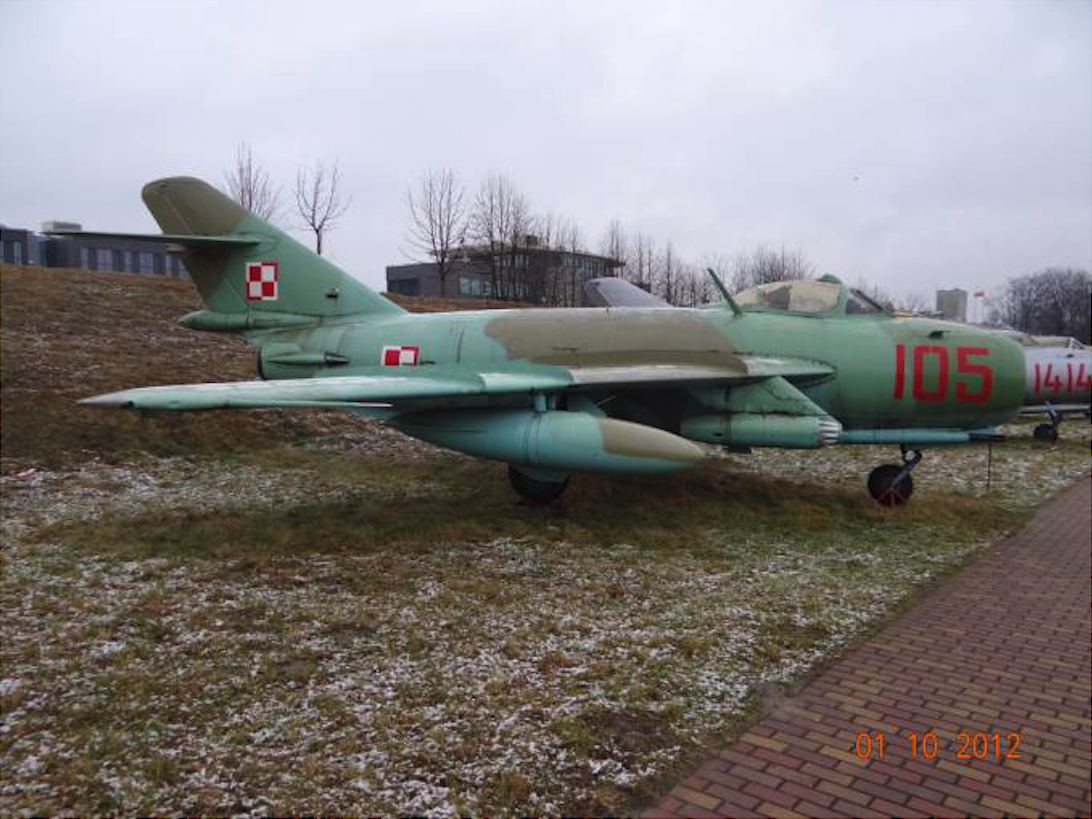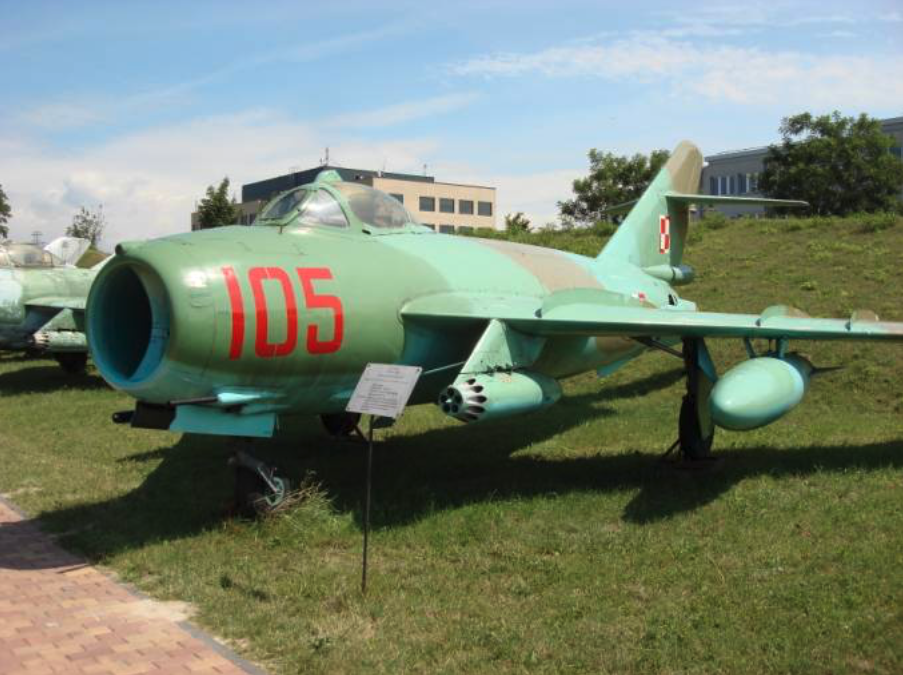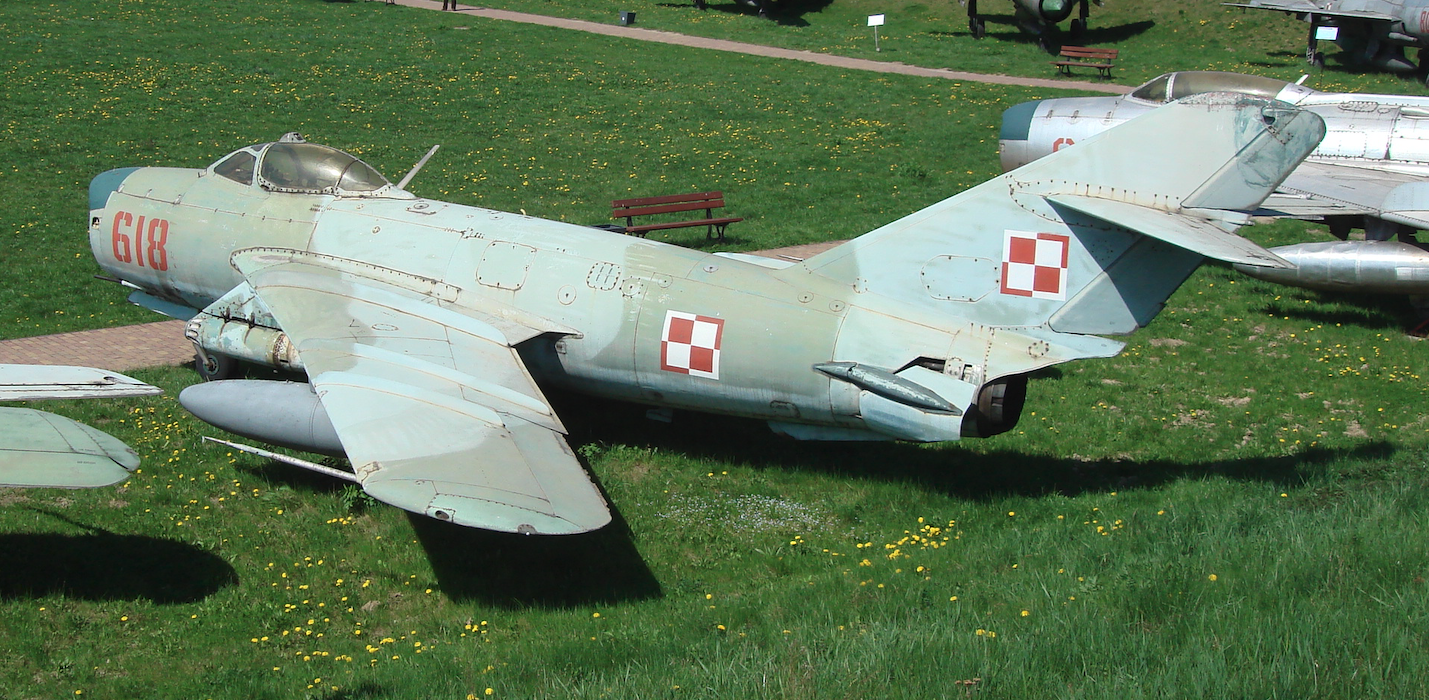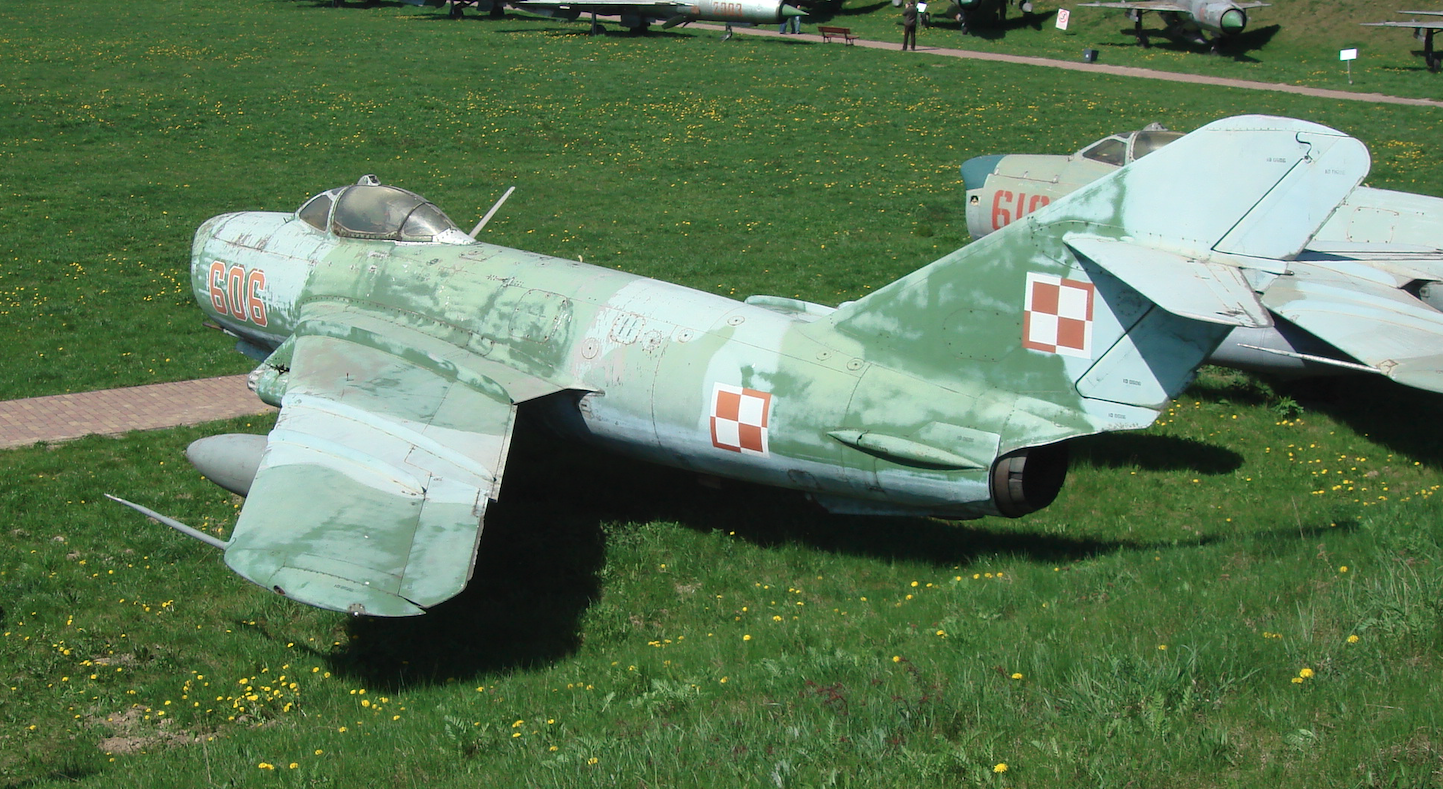Kraków 2007-05-01
167b Section 1959-07-02
WSK Mielec (LZR) Lim-5 M, Lim-6 bis, Lim-6 M (MR)
Poland
History
Fighter-attack and reconnaissance aircraft of direct support.
History Lim-5 M. 1959.
The development of nuclear weapons changed war doctrines. The role of piston assault aviation decreased. In Poland, there was no successor to the IL-10 aircraft, and CCCP did not work on this type of aircraft. New concepts for the use of fighter aircraft have emerged in Polish conditions. In 1960, fighter-assault aviation was established.
At the end of 1957, it was decided to modify the Lim-5 aircraft. The stimulus for modification was to become familiar with the requirements for a modern fighter-attack aircraft developed by the NATO staff in 1954. After detailed analysis, it turned out that the Lim-5 is close to meeting these requirements. Modification of the CF aircraft (Lim-5), codenamed CM. At the beginning of 1958, in Mielec under the direction of Ing. Feliks Borodzik began work on the Lim-5 M.
Due to the fact that the Lim-5 aircraft was a licensed version of the MiG-17 aircraft, and also because of the political realities at the time, on 1958-09-27, two designers from the Mielec office managed to consult with Moscow. There, as a result of several meetings, including the participation of Artiom Mikojan himself, the planned modification works were analyzed.
In order to accelerate modernization, changes were introduced in stages. The army provided the 1C 10-30 aircraft for reconstruction, and a few months later another 1C 16-01 aircraft.
In early 1958, the CM-I aircraft was created. Rocket accelerators, 2 x 9.81 kN, appeared on the sides of the rear of the fuselage. In the place where there is a fuselage comb, a PT-19 braking parachute was installed (other sources give the symbol SH-19).
The prototype with serial number CM-10-30 made the first flight on 1959-07-02. After completing the first stage trials, serial production was prepared without approval and without waiting for the flight to end. The take-off weight of the CM-I aircraft in the fighter configuration was 5 697 kg, and in the assault configuration 5 762 kg. The maximum speed was 1 080 km / h and the maximum ceiling was 14 100 m.
A little later than CM-I (CM 10-30) the CM-II project was created. The aircraft had double main landing gear wheels and fairing tanks at the fuselage in front of the flap. The fairing-tanks held 560 liters of fuel. Initially they were made of metal and later of composite. At this stage, the CM-II was named Lim-5 M.
On 1959-12-28, both prototypes, officially referred to as Lim-5 M, were transported to the field aerodrome and tested there. The purpose of these tests was to determine whether the tactical and technical effects had been achieved. The results were positive. The double wheels ensured that the fighter was completely dependent on concrete belts. Even cracks during the landing of one of the tires turned out to be harmless. The parachute shortened the run by 250 m. The take-off case was a bit worse. The take-off was extended by 40%, which was the result of a change in the wing’s aerodynamics. However, this was not worried because it was planned to use launch rockets, which were ultimately not tested. These studies exaggerated the referral of the machine to production.
Lim-5 M aircraft data were impressive. The run on grass was 710 – 770 m, and with accelerators 350 – 370 m (estimated data). Run-up to 1,140 m, and with a parachute 670 m. Mars tube launchers appeared in the armament; 2 x 8 x above sea level S-5. It was also possible to hang launchers for 16 or 24 rockets. The plane could have a garland suspension 2 x 3 heavy a.s. cal. 132 mm. There were various weapon combinations. Pilots called the plane a collar or a scarf because of the fairing-tanks.
On 1960-11-30, the first serial Lim-5 M with number 1F 01-01 was produced. (After years, this aircraft was rebuilt to Lim-6 bis.) Series production lasted until 1961-05-10 and ended with the construction of 60 aircraft in three series. The last one was 1F 03-30. Despite some comments on the aircraft, it was decided to use it, which was officially followed by the Order of the Ministry of National Defense No. 035 / MON issued on 1961-07-05.
Application Lim-5 M. 1961.
From December 1960, Lim-5 M aircraft were handed over to the air force, but Lim-5 M aircraft were not recognized in the regiments. The plane caused very big problems to users. It turned out that the plane was difficult to pilot. Its performance was worse than the standard Lim-5 aircraft. The flights were carried out with significant restrictions. Command assured pilots that they would soon receive a new improved type of stormtrooper. This happened only in 1963. Until then, the operational situation of Operational Aviation was getting worse. Even an emergency purchase of 70 used Soviet MiG-17 aircraft was planned, but this did not happen.
Operational Aviation was established through the separation of the Air Forces (WL) and the Defense Against National Aviation Area (OPL OK) in 1962.
In 1960-1961, 60 Lim-5 M aircraft built, went to the following combat units; 5 PLMSZ, 6 PLMSZ, 30 PLMSZ in Siemirowice and 48 PLMSZ. In 1963, the army had 44 Lim-5 M aircraft, respectively (18 units in 5 PLMSZ, 14 units in 6 PLMSZ, 16 units in 30 PLMSZ and 12 in 48 PLMSZ).
Lim-5 M aircraft went to Siemirowice, among others, in 1960. 30 PLSZ (assault aviation regiment) stayed there, which changed its name to 30 PLMSZ (fighter-assault regiment). In 1963, the regiment received TS-8 Bies school aircraft, and in 1964, Lim-6 bis aircraft described below. In 1967, 30 PLMSZ changed its name to 7 PLMSZ.
History Lim-6
The production of Lim-5 M aircraft did not mean the end of further modernization works. This was related to the CM-II project. The main theme of this project was the blowing of compressed air on the wing flaps. The goal was to achieve greater flap efficiency. The analysis showed that for the system to be fully effective, a plate type horizontal tail should be used. However, such a tail has never been built.
The work was carried out on a copy of CM 10-30 we already know. The first attempts to blow valves were encouraging. The specific solution has been tested since January 1961. The aircraft was designated Lim-5 M-II. The engine adapted for blowing is designated Lis-5 M. The air for blowing is led from the engine through a pipe placed inside the wing and equipped with numerous nozzles. However, over time, problems arose. On 1961-01-07, pumping occurred on the aircraft for the first time. It wasn’t until July 1961 that the problem was successfully solved by mounting check valves on the system. On 1962-03-29, after state trials, further attempts with blowing were discontinued due to too small benefits and great difficulty in servicing.
In 1960, the army submitted an additional 1C 19-04 aircraft for testing. A fully completed CM 16-01 copy was approved as a model CM-II program and given the designation Lim-5 M-II.
In May 1961, immediately after the production of Lim-5 M aircraft ceased, even before the Lim-5 M-II (CM 16-01) was fully tested, a series of 40 units was built, which was eventually given the Lim-6 designation. The engines changed their designation from Lis-5 M to Lis-6. The aircraft carried numbers from 1J 04-01 to 1J 04-40. As a side note, please note that CM 16-01 has been rebuilt several times.
The Lim-6 aircraft received, in addition to the installation of blowing on the flaps and the parachute located at the base of the tail, many other small changes. For example, additional lateral engine cooling, which was to be an introduction to the desirability of developing side air intakes. However, in this form the Lim-6 aircraft was never taken over by the army. Lim-6 aircraft were rebuilt after a while.
There were other modifications to the Lim-5 M aircraft that were not implemented. Among other things, the plane with containers at the wing tips, which housed cameras of various types. The coasting shortening system was also tested using two parachutes. Unfortunately, one parachute disturbed the opening of the second canopy, so the attempts were not continued.
History Lim-6 bis. 1962.
The Polish Army did not accept Lim-6 aircraft for arming. Some of the Lim-6 machines were used for further tests. These included planes with numbers; 1J 04-02, -03, -04, -05.
Information coming from the regiments about the operation of Lim-5 M aircraft and conducted research forced further changes. On 1962-04-24, a meeting of the Technical Commission for Lim-6 aircraft took place. Attention was paid to the deteriorated pilotage with fairing-tanks and the low efficiency of blowing on the flaps. It was postulated to give up these solutions.
At the beginning, the fairing was removed. Airplanes with fairing tanks had a thicker wing. In flight, he resisted and fuel consumption increased. In addition, as the fuel depleted from the tanks, the center of gravity shifted. The maneuverability of the aircraft deteriorated, which was attributed to some accidents. The main goal – the increase in range was not so significant.
The chassis with double wheels lasted longer. However, they required additional fairing that worsened the flight properties. Tests showed aircraft vibration and fluctuations in flight. In addition, the importance of using ground airports was diminishing. That is why it was decided to give up double wheels. However, until the end of aircraft life, there was always the option of using this option and installing dual wheels.
As we mentioned above, we also gave up blowing on the flaps. However, additional booms for armament appeared on the plane. On 1962-06-19, trials on the 1C 19-04 aircraft began. They concerned various weapon variants. The tests were completed in 1962-08-06, after 63 flights. The experimental pilot was Z. Słonowski. Good flight properties were found, especially with Mars-2 armament on internal nodes.
As we remember, the plane could be equipped with rocket accelerators. In the second half of 1962, it was planned to equip the aircraft with higher thrust accelerators, 2 x 11.77 kN. Ultimately, however, due to the smaller increase in the aircraft’s own weight, the rocket accelerators were abandoned.
On 1962-06-25, the Ministry of National Defense approved the establishment of the CMR program, i.e. the assault and reconnaissance version. As we mentioned above, the tests of various reconnaissance tanks mounted under the wings were unsuccessful, therefore the cameras mounted only in the hull were ultimately left. This solution was tested in the period from June to August 1962. As a side note, we will mention that the first Lim-5 aircraft equipped with the AFA-39 camera was a 1C 13-18 copy, and work was carried out in 1959.
In 1962-08-28, the first armament tests were carried out, when the Lim-6 bis CM 10-30 prototype used FAB-250, OFAB-100 bombs and S-5 unguided missiles.
On 1962-09-13, decisions were made: It was decided to rebuild the Lim-6 aircraft produced to the Lim-6 bis standard, with the option of building 70 new machines by the end of 1963. In 1964, it was planned to build an additional 56 aircraft in a typical reconnaissance version of the Lim-6 R. This last plan was not implemented, because the production of TS-11 Iskra aircraft was started. It was therefore decided that the Lim-6 bis V and VI series aircraft will be equipped with an AFA-39 camera placed in the fuselage. The name Lim-6 bis R or Lim-6 R was even proposed, but this idea was abandoned.
On 1962-11-07, the final version of the assault plane called Lim-6 bis was approved. On 1962-12-05, factory tests began, which lasted until 1963-04-16. At the beginning of 1963, reconstruction of Lim-6 planes to the Lim-6 bis variant began. Just those produced and not picked up by the army. The first aircraft 1J 04-07 left WSK Mielec on 1963.03.23. 70 aircraft were built from scratch, in two series, V and VI. The last one was a 1J 06-40 copy, it was built on 1964-02-25. All Lim-5 M aircraft were rebuilt to the Lim-6 bis version. These works were carried out in LZR-4.
Later, another 1J 16-01 was handed over to military units, being the experimental CM 16-01 (1965-06-15) and 1J 04-41 (1969-09-30).
From 1964-04-15 to 1964-06-27, state tests of the aircraft were carried out. Some minor defects were noted and their removal ordered. The Lim-6 bis aircraft was officially accepted for service on 1964-09-14, when the state test report was approved.
Lim-6 M / MR. 1971.
As time passed, the Lim-5 P interceptors (those with radar sights) used by the military ceased to fulfill their role. Because they had a long service life of airframes, it was decided to rebuild them into fighter-attack versions.
The Radar Station has been removed from the aircraft. To maintain aerodynamic balance, the aircraft moved the battery forward and added weight. The AFA-39 camera was installed. Additional weapon tabs have been added. Generally, no braking parachute was installed, which shortened the run down. But there were exceptions.
Works were carried out in LZR-2 in Bydgoszcz. The aircraft were initially designated Lim-5 P bis, but eventually the name Lim-6 M was adopted. The designation Lim-6 MR was also used. The first aircraft rebuilt in 1971 was the 1D 06-02 aircraft. In 1972-1978, about 60 Lim-5 P machines were rebuilt to the Lim-6 M standard.
Polish modernization of Lim-5 aircraft has also become the subject of export to the GDR. As part of aircraft repairs, additional catches were built for the Mars-2 launcher, a total of 30 sets, or 60 catches.
Written by Karol Placha Hetman




